
S&P 500
Last analysis again expected upwards movement, which is exactly how the week ended, with a strong green candlestick for Friday.
Summary: The target is now at 2,922.
Traders with a lower risk appetite may set stops just below yesterday’s low. For those comfortable with the possibility of an underwater position for a few days, stops may be just below 2,553.80.
A more cautious approach here may be to wait for an upwards breakout above the triangle B-D trend line before entering another long position.
There is again bullish divergence between price and On Balance Volume, VIX and the AD line. It looks like a low is in place.
Always practice good risk management. Always trade with stops and invest only 1-5% of equity on any one trade.
The biggest picture, Grand Super Cycle analysis, is here.
Last historic analysis with monthly charts is here. Video is here.
An alternate idea at the monthly chart level is given here.
An historic example of a cycle degree fifth wave is given at the end of the analysis here.
MAIN ELLIOTT WAVE COUNT
WEEKLY CHART
Cycle wave V must complete as a five structure, which should look clear at the weekly chart level. It may only be an impulse or ending diagonal. At this stage, it is clear it is an impulse.
Within cycle wave V, the third waves at all degrees may only subdivide as impulses.
Intermediate wave (4) has breached an Elliott channel drawn using Elliott’s first technique. The channel is redrawn using Elliott’s second technique: the first trend line from the ends of intermediate waves (2) to (4), then a parallel copy on the end of intermediate wave (3). Intermediate wave (5) may end either midway within the channel, or about the upper edge.
At least three wave counts remain valid at the daily chart level. It is possible still that a low may not be in place; intermediate wave (4) could still continue further. Intermediate wave (4) may not move into intermediate wave (1) price territory below 2,193.81. However, it would be extremely likely to remain within the wider teal channel (copied over from the monthly chart) if it were to be reasonably deep. This channel contains the entire bull market since the low in March 2009, with only two small overshoots at the end of cycle wave IV. If this channel is breached, then the idea of cycle wave V continuing higher would be discarded well before the invalidation point is breached.
Intermediate wave (4) may now be a complete regular contracting triangle lasting fourteen weeks, one longer than a Fibonacci thirteen. There is perfect alternation and excellent proportion between intermediate waves (2) and (4).
At this stage, there are still three possible structures for intermediate wave (4): a triangle, a combination, and a flat correction. All three will be published. The triangle is preferred because that would see price find support about the 200 day moving average. While this average provides support, it is reasonable to expect it to continue (until it is clearly breached).
The triangle may be complete now, but the other two possibilities of a flat and combination may be incomplete.
DAILY CHART
It is possible that intermediate wave (4) is a complete regular contracting triangle, the most common type of triangle. Minor wave E may have found support just above the 200 day moving average and ending reasonably short of the A-C trend line. This is the most common look for E waves of triangles.
Intermediate wave (3) exhibits no Fibonacci ratio to intermediate wave (1). It is more likely then that intermediate wave (5) may exhibit a Fibonacci ratio to either of intermediate waves (1) or (3). The most common Fibonacci ratio would be equality in length with intermediate wave (1), but in this instance that would expect a truncation. The next common Fibonacci ratio is used to calculate a target for intermediate wave (5) to end.
It must still be accepted that the risk with this wave count is that a low may not yet be in place; intermediate wave (4) could continue lower. For this triangle wave count, minor wave E may not move beyond the end of minor wave C below 2,553.80.
When price has clearly broken out above the upper triangle B-D trend line, then the invalidation point may be moved up to the end of intermediate wave (4).
ALTERNATE WAVE COUNTS
DAILY CHART – COMBINATION
I have charted a triangle a great many times over the years, sometimes even to completion, only to see the structure subsequently invalidated by price. When that has happened, the correction has turned out to be something else, usually a combination. Therefore, it is important to always consider an alternate when a triangle may be unfolding or complete.
Double combinations are very common structures. The first structure in a possible double combination for intermediate wave (4) would be a complete zigzag labelled minor wave W. The double should be joined by a three in the opposite direction labelled minor wave X, which may be a complete zigzag. X waves within combinations are typically very deep; if minor wave X is over at the last high, then it would be a 0.79 length of minor wave W, which is fairly deep giving it a normal look. There is no minimum nor maximum requirement for X waves within combinations.
The second structure in the double would most likely be a flat correction labelled minor wave Y. It may also be a triangle, but at this stage the expected direction for that idea does not differ now from the main wave count.
A flat correction would subdivide 3-3-5. Minute wave a must be a three wave structure, most likely a zigzag. It may also be a double zigzag.
Minute wave b must now reach a minimum 0.90 length of minute wave a. Minute wave b may be unfolding as a double zigzag. Within a double zigzag, the second zigzag exists to deepen the correction when the first zigzag did not move price deep enough. Double zigzags normally have a strong slope like single zigzags. To achieve a strong slope the X wave within a double zigzag is normally brief and shallow, most importantly shallow (it rarely moves beyond the start of the first zigzag). A new low now below 2,586.27 should see the idea of a double zigzag for minute wave b discarded.
The purpose of combinations is to take up time and move price sideways. To achieve this purpose the second structure in the double usually ends close to the same level as the first. Minor wave Y would be expected to end about the same level as minor wave W at 2,532.69. This would require a strong overshoot or breach of the 200 day moving average, which looks unlikely but does have precedent in this bull market.
Minute wave b may make a new high above the start of minute wave a if minor wave Y is an expanded flat. There is no maximum length for minute wave b, but there is a convention within Elliott wave that states when minute wave b is longer than twice the length of minute wave a the idea of a flat correction continuing should be discarded based upon a very low probability. That price point would be at 3,050. However, if price makes a new all time high and upwards movement exhibits strength, then this idea would be discarded at that point. Minute wave b should exhibit obvious internal weakness, not strength.
At this stage, the very bullish signal last week from the AD line making a new all time high puts substantial doubt on this wave count. It has very little support from classic technical analysis.
DAILY CHART – FLAT
Flat corrections are very common. The most common type of flat is an expanded flat. This would see minor wave B move above the start of minor wave A at 2,872.87.
Within a flat correction, minor wave B must retrace a minimum 0.9 length of minor wave A at 2,838.85. The most common length for minor wave B within a flat correction would be 1 to 1.38 times the length of minor wave A at 2,872.87 to 3,002.15. An expanded flat would see minor wave B 1.05 times the length of minor wave A or longer, at 2,889.89 or above. A target is calculated for minor wave B to end, which would see it end within the common range.
Minor wave B may be a regular flat correction, and within it minute wave a may have been a single zigzag and minute wave b may have been a double zigzag. This has a very good fit.
However, minute wave c must be a five wave structure for this wave count and now the depth and duration of subminuette wave ii looks wrong. The probability that minute wave c upwards is unfolding as an impulse is now reduced. It is possible that it could be a diagonal, but that too has a relatively low probability as the diagonal would need to be expanding to achieve the minimum price target for minor wave B, and expanding ending diagonals are not very common.
At its end minor wave B should exhibit obvious weakness. If price makes a new all time high and exhibits strength, then this wave count should be discarded.
This wave count would require a very substantial breach of the 200 day moving average for the end of intermediate wave (4). This is possible but may be less likely than a smaller breach. The bullish signal from the AD line making a new all time high puts substantial doubt on this wave count.
TECHNICAL ANALYSIS
WEEKLY CHART
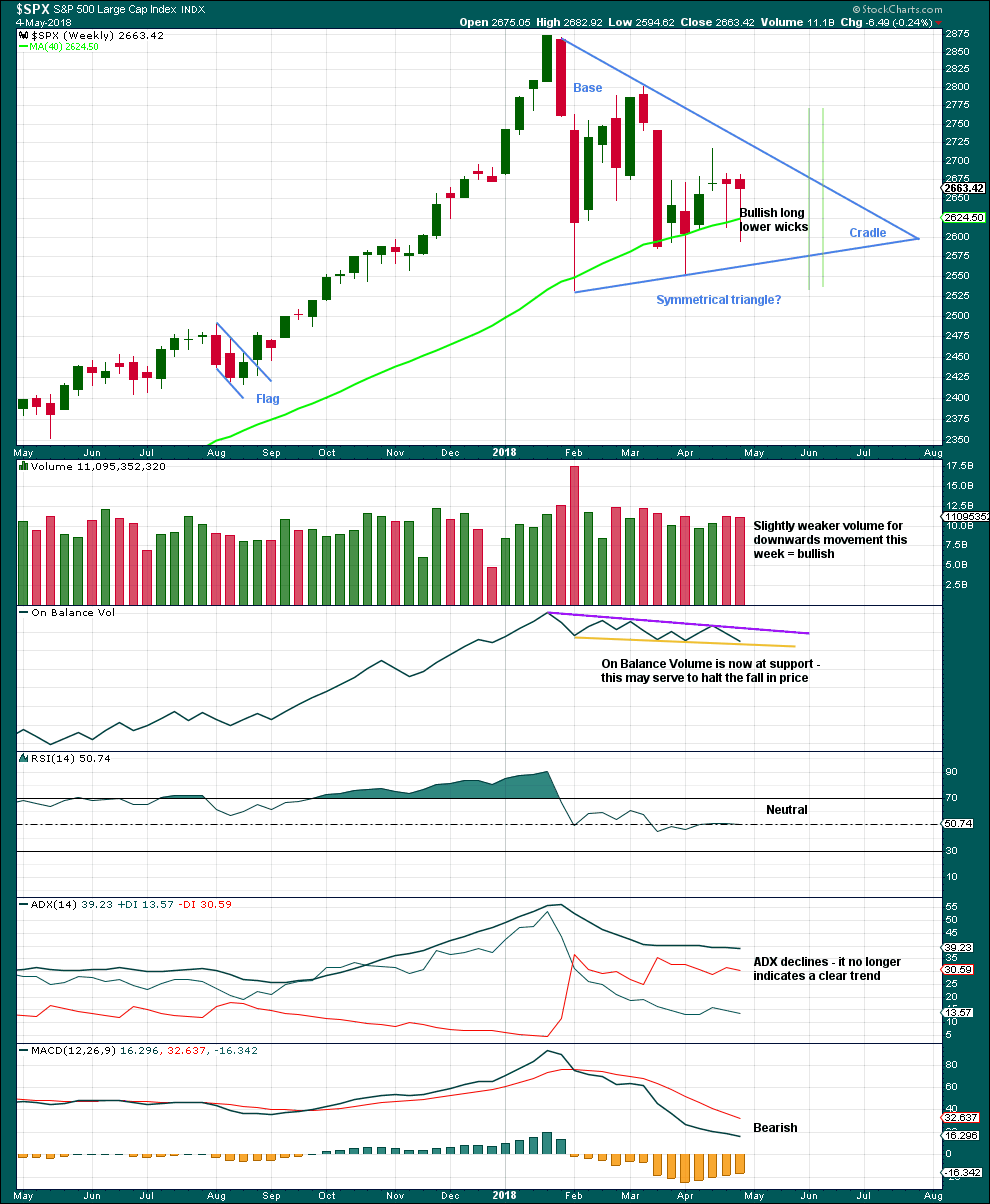
Click chart to enlarge. Chart courtesy of StockCharts.com.
A classic symmetrical triangle pattern may be forming. These are different to Elliott wave triangles. Symmetrical triangles may be either continuation or reversal patterns, while Elliott wave triangles are always continuation patterns and have stricter rules.
The vertical green lines are 73% to 75% of the length of the triangle from cradle to base, where a breakout most commonly occurs.
From Dhalquist and Kirkpatrick on trading triangles:
“The ideal situation for trading triangles is a definite breakout, a high trading range within the triangle, an upward-sloping volume trend during the formation of the triangle, and especially a gap on the breakout.”
For this example, the breakout has not yet happened. There is a high trading range within the triangle, but volume is declining.
The triangle may yet have another 5 – 6 weeks if it breaks out at the green lines.
Now two bullish long lower wicks are complete, and the second wick is even longer so more bullish. On Balance Volume is at support, which may halt the fall in price. The resistance line on On Balance Volume this week is slightly adjusted to have stronger technical significance.
DAILY CHART
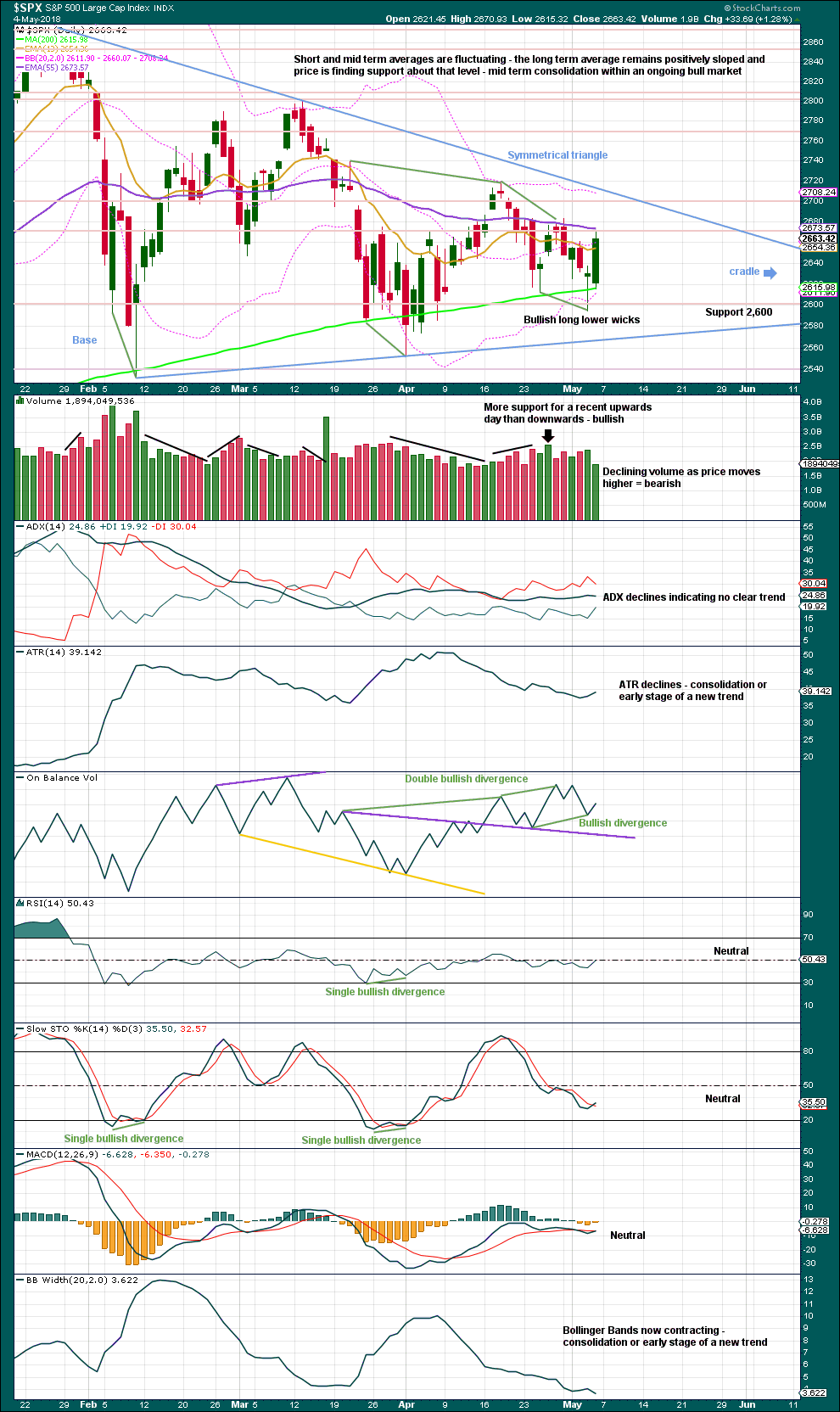
Click chart to enlarge. Chart courtesy of StockCharts.com.
During this large consolidation, there are two green daily candlesticks with strongest volume:
1. the 6th of February was a downwards day, but it closed green and the balance of volume that day was upwards; this has the strongest volume during the consolidation.
2. the 16th of March was an inside day, which closed green and has the balance of volume upwards; this has the next strongest volume.
This market has been range bound since the last all time high. Volume suggests an upwards breakout is more likely than downwards. With price coiling in an ever decreasing range, it looks like a classic symmetrical triangle is forming. These are similar but not completely the same as Elliott wave triangles. Symmetrical triangles may be either continuation or reversal patterns while Elliott wave triangles are always continuation patterns.
Breakouts from symmetrical triangles most commonly occur from 73% to 75% of the length from base to cradle. In this instance, that would be in another 18 to 20 sessions. A breakout should be a close above or below the triangle trend lines, and an upwards breakout should have support from volume for confidence.
After an upwards breakout, pullbacks occur 59% of the time. After a downwards breakout, throwbacks occur 37% of the time.
After a breakout, the base distance (the vertical distance between the initial upper and lower reversal point prices) may be added to the breakout price point to calculate a target. Here, the base distance is 320.28 points.
There are now two instances of recent bullish divergence between price and On Balance Volume. Price has made a new swing low below the prior low of the 25th of April, but On Balance Volume has not. This indicates weakness in price and is bullish.
It is concerning for bulls though that despite a strong green daily candlestick for Friday volume was very light. But bullish signals from On Balance Volume should be given more weight.
VOLATILITY – INVERTED VIX CHART
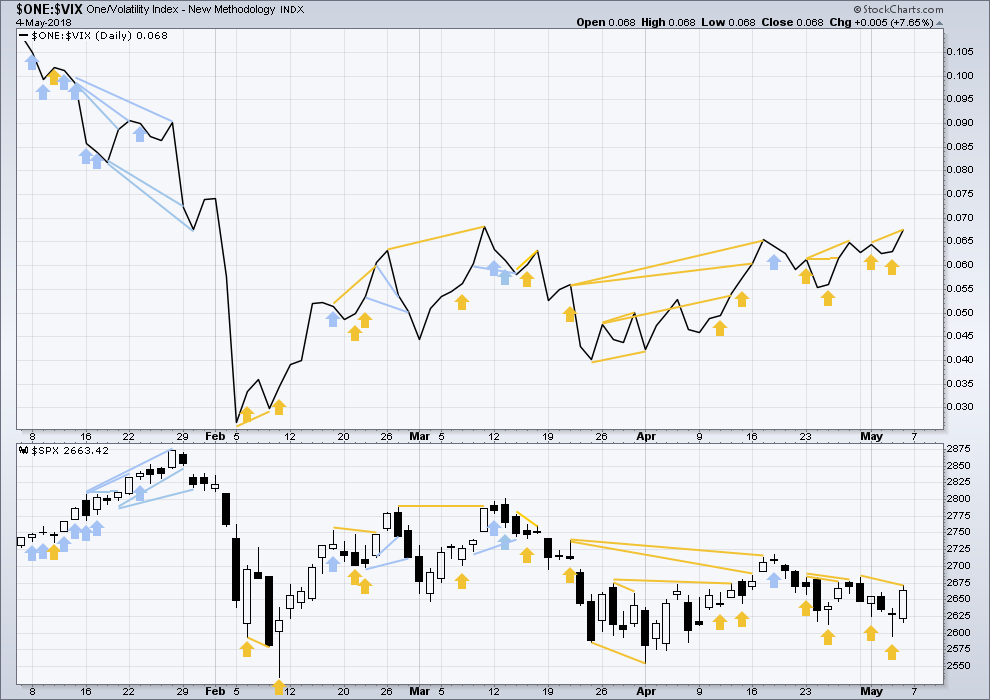
Click chart to enlarge. Chart courtesy of StockCharts.com.
So that colour blind members are included, bearish signals will be noted with blue and bullish signals with yellow.
Normally, volatility should decline as price moves higher and increase as price moves lower. This means that normally inverted VIX should move in the same direction as price.
There is still a cluster of bullish signals on inverted VIX. Overall, this may offer support to the main Elliott wave count.
Inverted VIX has made a small new swing high, but price has not. This divergence is bullish. The cluster of bullish signals is increasing.
BREADTH – AD LINE
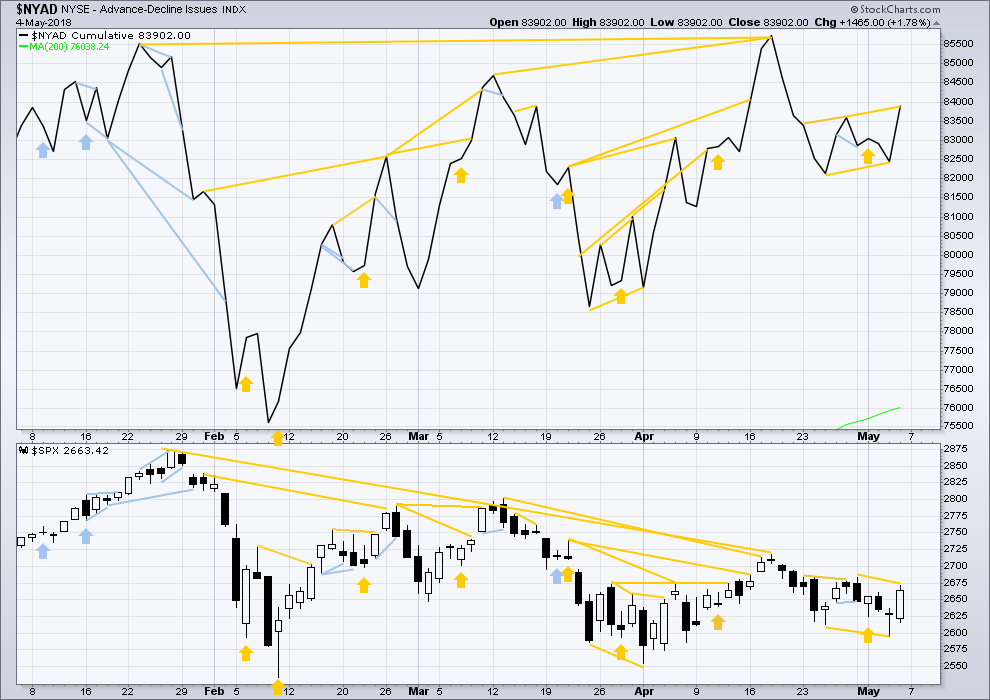
Click chart to enlarge. Chart courtesy of StockCharts.com.
There is normally 4-6 months divergence between price and market breadth prior to a full fledged bear market. This has been so for all major bear markets within the last 90 odd years. With no longer term divergence yet at this point, any decline in price should be expected to be a pullback within an ongoing bull market and not necessarily the start of a bear market. A new all time high from the AD line this week means that any bear market may now be an absolute minimum of 4 months away.
For most recent days, both mid and small caps have now made new small swing highs above the prior highs of the 30th of April (mid caps) and the 26th of April (small caps). Only large caps have not yet made new small swing high above the 30th of April. Small and mid caps may be leading the market. This divergence is interpreted as bullish.
Breadth should be read as a leading indicator.
The new all time high from the AD line remains very strongly bullish and supports the main Elliott wave count.This new all time high from the AD line will be given much weight in this analysis. This is the piece of technical evidence on which I am relying most heavily in expecting a low may be in place here or very soon.
There has been a cluster of bullish signals from the AD line in the last few weeks. This also overall offers good support to the main Elliott wave count.
Last bullish divergence has been followed by a strong upwards day. There is new bullish divergence today: the AD line has made a small new swing high, but price has not. With the AD line a leading indicator, price may follow through with a new small swing high also.
DOW THEORY
The following lows need to be exceeded for Dow Theory to confirm the end of the bull market and a change to a bear market:
DJIA: 23,360.29.
DJT: 9,806.79.
S&P500: 2,532.69.
Nasdaq: 6,630.67.
At this stage, only DJIA has made a new major swing low. DJT also needs to make a new major swing low for Dow Theory to indicate a switch from a bull market to a bear market. For an extended Dow Theory, which includes the S&P500 and Nasdaq, these two markets also need to make new major swing lows.
GOLD
Although it is slow, upwards movement continues as expected.
Summary: It still looks like a low is in place. Price closed within support and Stochastics is oversold and exhibits bullish divergence. Expect an upwards swing at least, and likely an upwards breakout from the consolidation that Gold has been in since January.
The target is now at 1,431.
Always trade with stops to protect your account. Risk only 1-5% of equity on any one trade.
Grand SuperCycle analysis is here.
Last in-depth historic analysis with monthly and several weekly charts is here, video is here.
There are multiple wave counts at this time at the weekly and monthly chart levels. In order to make this analysis manageable and accessible only two will be published on a daily basis, one bullish and one bearish. This does not mean the other possibilities may not be correct, only that publication of them all each day is too much to digest. At this stage, they do not diverge from the two possibilities below.
BULLISH ELLIOTT WAVE COUNT
FIRST WEEKLY CHART
Cycle wave b may be a single zigzag. Zigzags subdivide 5-3-5. Primary wave C must subdivide as a five wave structure and may be either an impulse or an ending diagonal. Overlapping at this stage indicates an ending diagonal.
Within an ending diagonal, all sub-waves must subdivide as zigzags. Intermediate wave (4) must overlap into intermediate wave (1) price territory. This diagonal is expanding: intermediate wave (3) is longer than intermediate wave (1) and intermediate wave (4) is longer than intermediate wave (2). Intermediate wave (5) must be longer than intermediate wave (3), so it must end above 1,398.41 where it would reach equality in length with intermediate wave (3).
Within the final zigzag of intermediate wave (5), minor wave B may not move beyond the start of minor wave A below 1,236.54. However, if it were now to turn out to be relatively deep, it should not get too close to this invalidation point as the lower (2)-(4) trend line should provide strong support. Diagonals normally adhere very well to their trend lines.
Within the diagonal of primary wave C, each sub-wave is extending in price and so may also do so in time. Within each zigzag, minor wave B may exhibit alternation in structure and may show an increased duration.
Within intermediate wave (1), minor wave B was a triangle lasting 11 days. Within intermediate wave (3), minor wave B was a regular flat lasting 60 days. Intermediate wave (5) is expected to be longer in price than intermediate wave (3), and it may also be longer in duration, and so minor wave B within it may also be longer in duration. If minor wave B is over at the last low, it would have lasted 68 days.
This first weekly chart sees the upwards wave labelled primary wave A as a five wave structure. It must be acknowledged that this upwards wave looks better as a three than it does as a five. The fifth weekly chart below will consider the possibility that it was a three.
FIRST DAILY CHART
Minor wave B may be a complete single regular flat correction. Within the flat, minute wave a is a three, a single zigzag, and minute wave b is a three, a double zigzag, and minute wave c is a five that has moved price slightly below the end of minute wave a. There is a very close Fibonacci ratio of equality between minute waves a and c.
Regular flats normally fit very well into parallel channels. Minute wave c has found support almost exactly at the lower edge of this channel. This gives the flat correction the right look.
BEARISH ELLIOTT WAVE COUNT
FIFTH WEEKLY CHART
There were five weekly charts published in the last historic analysis. This fifth weekly chart is the most immediately bearish wave count, so this is published as a bearish possibility.
This fifth weekly chart sees cycle wave b as a flat correction.
If cycle wave b is a flat correction, then within it primary wave B must retrace a minimum 0.9 length of primary wave A at 1,079.13 or below. The most common length of B waves within flats is from 1 to 1.38 times the length of the A wave. The target calculated would see primary wave B end within this range.
Primary wave B may be subdividing as a regular flat correction, and within it both intermediate waves (A) and (B) subdivide as three wave structures. Intermediate wave (B) fits as a triple zigzag.
I have only seen two triple zigzags before during my 10 years of daily Elliott wave analysis. If this wave count turns out to be correct, this would be the third. The rarity of this structure is identified on the chart.
FIFTH DAILY CHART
Minor wave 1 may have been a relatively brief impulse over at the low of the 8th of February. Thereafter, minor wave 2 may be an incomplete double combination.
The first structure in the double may be a zigzag labelled minute wave w. The double may be joined by a three in the opposite direction, a zigzag labelled minute wave x. The second structure in the double may be an incomplete running triangle labelled minute wave y. This structure may yet take some weeks to complete. In my experience a double combination with a triangle for minute wave y is not very common. This reduces the probability of this wave count, but it remains valid.
This wave count is a good solution for this bearish wave count. All subdivisions fit and there are no rare structures so far within intermediate wave (C).
TECHNICAL ANALYSIS
WEEKLY CHART
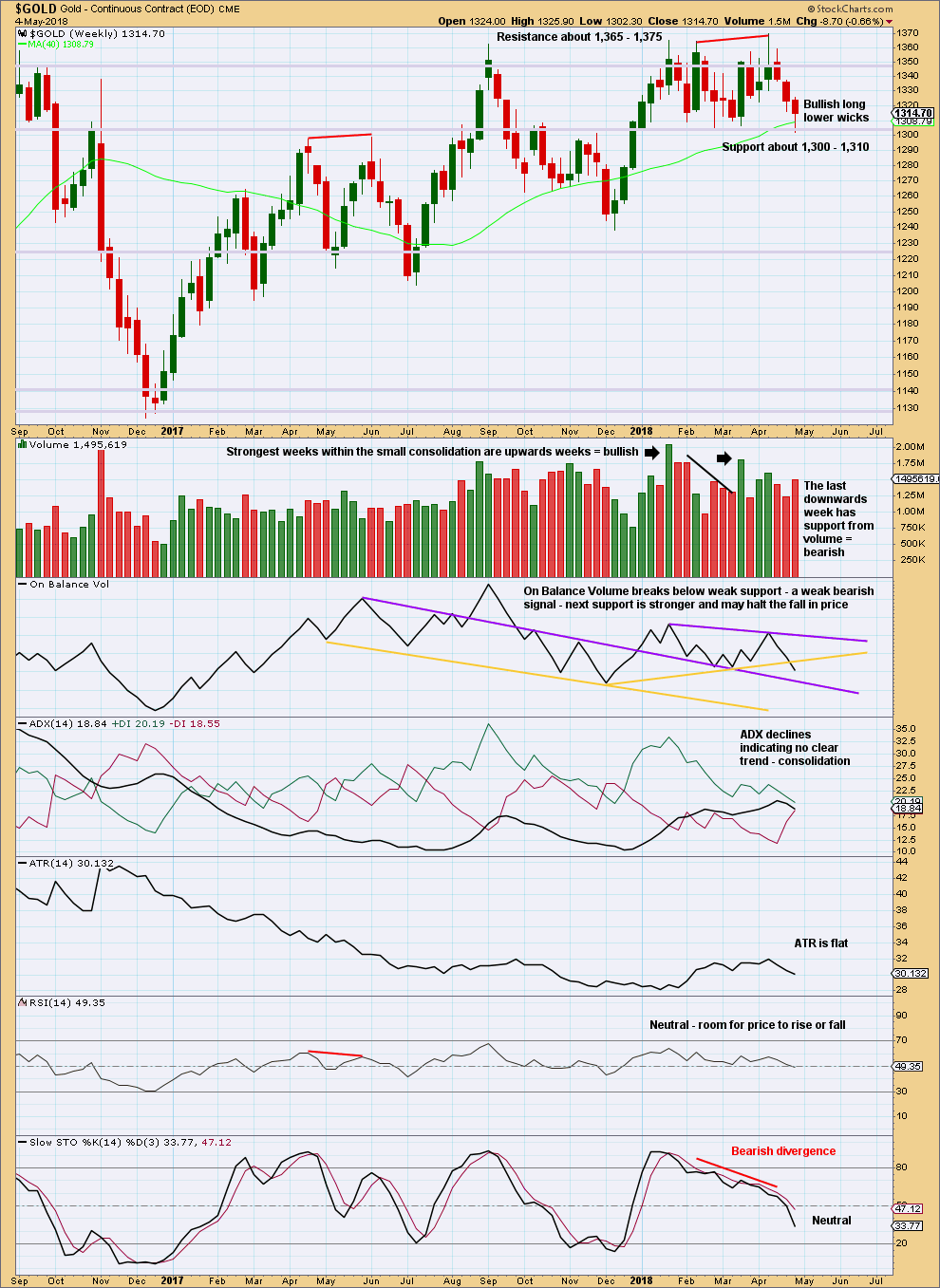
Click chart to enlarge. Chart courtesy of StockCharts.com.
Gold is within a small consolidation with resistance about 1,365 to (final) 1,375 and strong support about 1,310 to 1,305. Volume suggests an upwards breakout is more likely than downwards.
This week has a long lower wick deep in support. The long wick again suggests a bounce here, particularly as it is at strong support.
The bearish signal this week from On Balance Volume is weak, because the line is not very long held and has a reasonable slope, but it is however a bearish signal to consider. The line was tested at least three times before, so it does have some weak technical significance.
The bottom line is price remains range bound. The longer price is range bound, the stronger and more violent the breakout movement will be when support or resistance is broken.
DAILY CHART
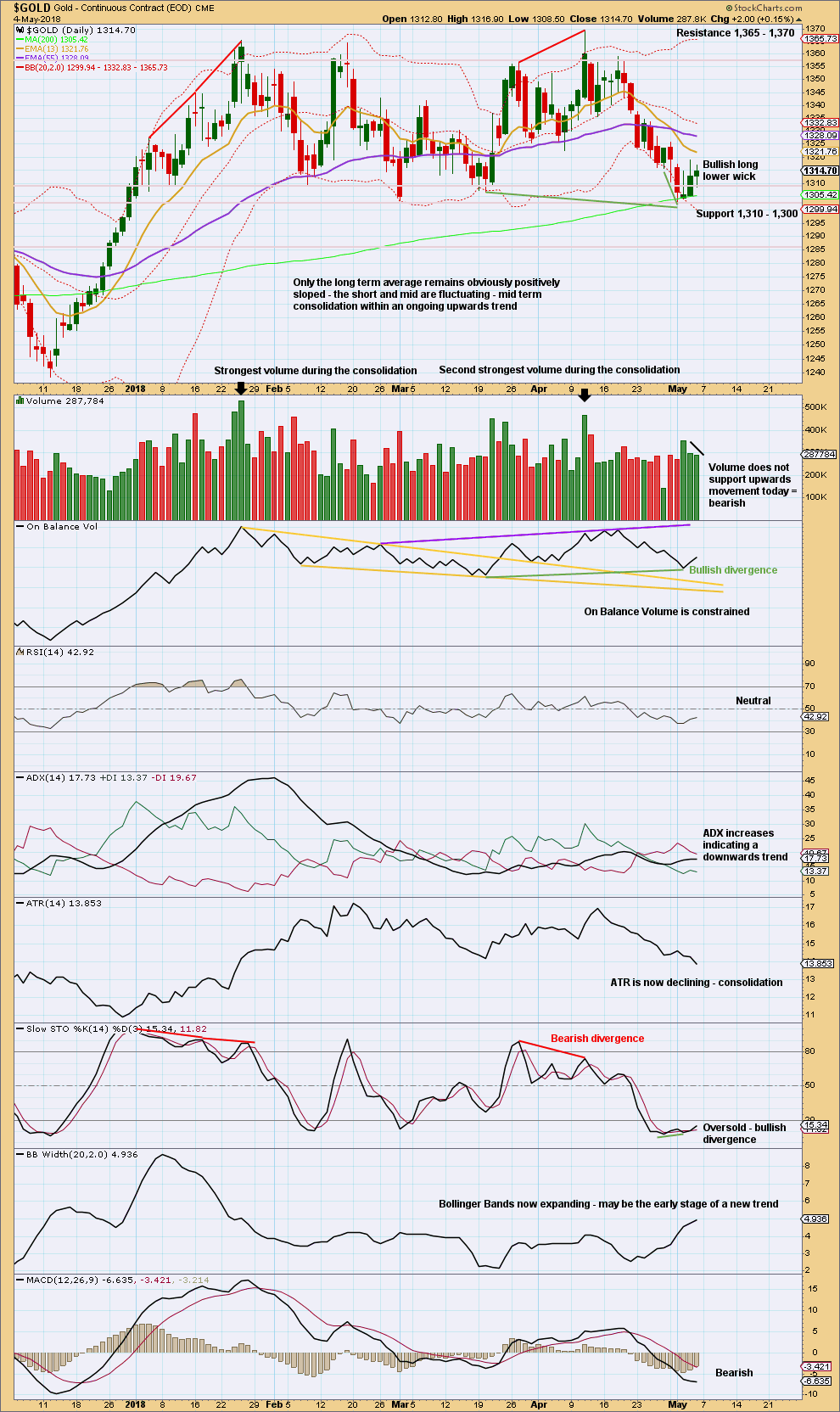
Click chart to enlarge. Chart courtesy of StockCharts.com.
Gold is within a smaller consolidation that began back on about the 3rd of January. This consolidation is delineated by resistance about 1,360 to 1,365 and support about 1,310 to 1,300. It is the upwards days of the 15th of January and the 11th of April that have strongest volume. This strongly suggests an upwards breakout may be more likely than downwards.
Price was at resistance and exhibited divergence with Stochastics at the last high. Price has found support. Bullish divergence with Stochastics while it is oversold is now clearer. With two long lower wicks and support about the 200 day moving average, it looks like Gold has found a low.
There is still cause for concern here that a low is in place. The short term volume profile is still bearish.
It is noted that although price has made a new low below the prior low of the 20th of March, On Balance Volume has not. This divergence is bullish and supports the main Elliott wave count. On Balance Volume is an indicator that I will give reasonable weight to.
GDX WEEKLY CHART
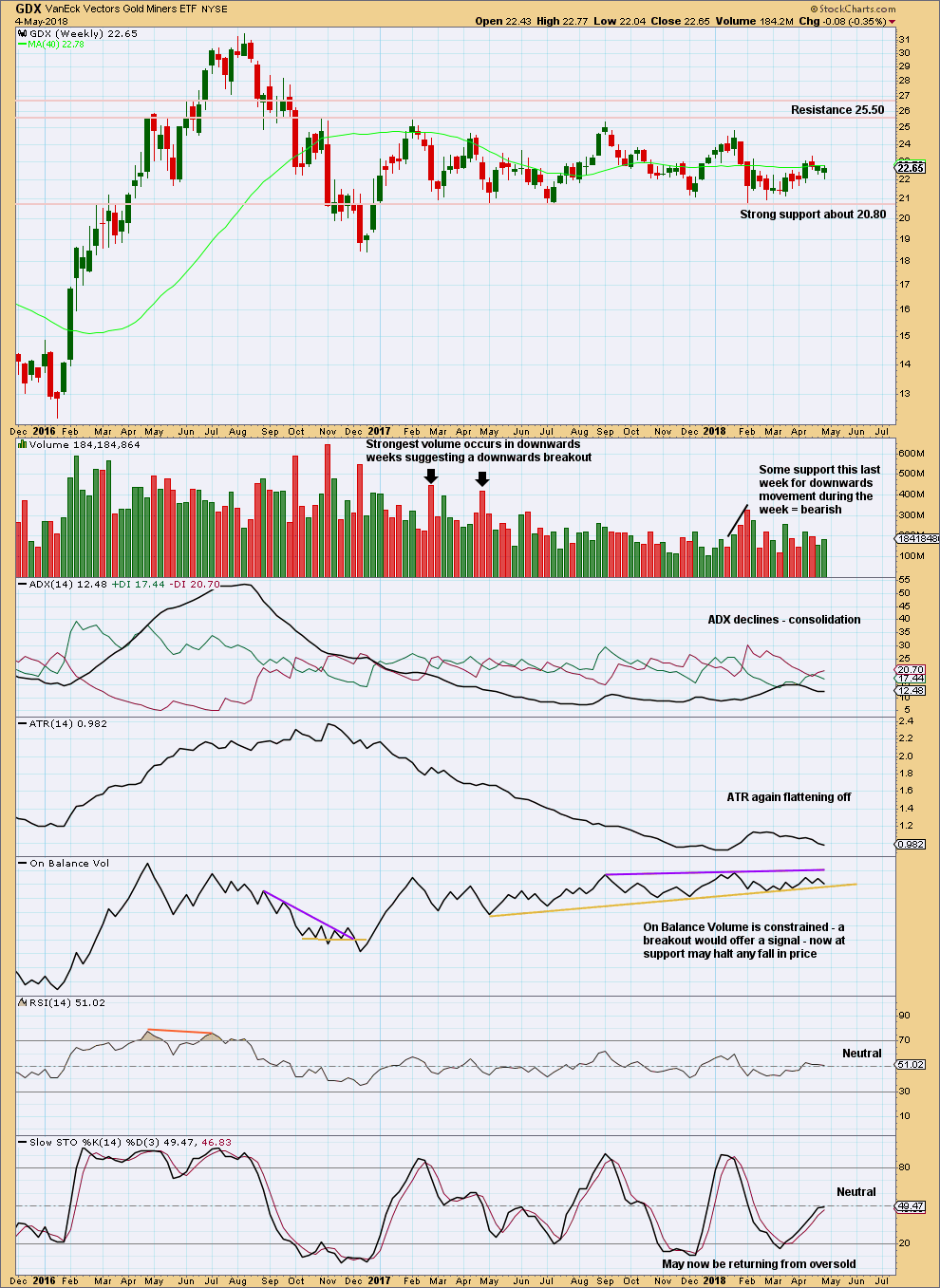
Click chart to enlarge. Chart courtesy of StockCharts.com.
Support about 20.80 has been tested about eight times and so far has held. The more often a support area is tested and holds, the more technical significance it has.
In the first instance, expect this area to continue to provide support. Only a strong downwards day, closing below support and preferably with some increase in volume, would constitute a downwards breakout from the consolidation that GDX has been in for a year now.
Resistance is about 25.50. Only a strong upwards day, closing above resistance and with support from volume, would constitute an upwards breakout.
Overall, a slow upwards swing may be underway. Do not expect it to move in a straight line; it may have downwards weeks within it.
The short term volume profile remains bearish. Look out for a pullback within the upwards swing.
GDX DAILY CHART

Click chart to enlarge. Chart courtesy of StockCharts.com.
On trading triangles from Dhalquist and Kirkpatrick, page 319:
“The ideal situation for trading triangles is a definite breakout, a high trading range within the triangle, an upward-sloping volume trend during the formation of the triangle, and especially a gap on the breakout. These patterns seem to work better with small-cap stocks in a rising market.
Although triangles are plentiful, their patterns suffer from many false and premature breakouts. This requires that a very strict breakout rule be used, either a wide filter or a number of closes outside the breakout zone. It also requires a close protective stop at the breakout level in case the breakout is false. Once these defensive levels have been exceeded, and price is on its way, the trader can relax for a little while because the failure rate after a legitimate breakout is relatively low. Trailing stops should then be placed at each preceding minor reversal.
…. in symmetrical triangles, the best performance comes from late breakouts in the 73% – 75% distance.
Volume on the breakout seems more desirable in symmetrical triangles.”
In this case, the breakout has come 61% of the triangle length from base to cradle. Volume towards the end of the triangle declined. The breakout is accompanied by a gap and has good support from volume.
Pullbacks occur 59% of the time for symmetrical triangles.
It looks like the pullback may be over. Price found support.
On Balance Volume gives a clear bullish signal with a break above resistance. This signal is reasonable as this resistance line is long held and tested many times. But it is not very strong because it has been broken once and has a reasonable slope. This could turn out to be another false signal.
It should also be noted that since the 28th of February On Balance Volume has been overall rising, which is bullish. On Balance Volume has made a new high above the high of the 19th of April, but price has not. This is also bullish.
Contradicting the bullishness from On Balance Volume is the short term volume profile, which is bearish, and a low range within the last two green daily candlesticks. The last low may yet be tested before an upwards trend is ready to take off.
US OIL
A new high on Friday for US Oil shifts the probabilities of the three daily Elliott wave counts.
Summary: Classic technical analysis remains overly bullish. There is an upwards trend in place. Pullbacks are an opportunity to join the trend.
The preferred Elliott wave count is very bullish, now well in line with classic technical analysis. It expects a short term pullback but only to 66.02 – 65.19. Thereafter, it expects upwards movement to increase in momentum. The mid term target is now at 97.92. A longer term target is at 106.25.
Always practice good risk management as the most important aspect of trading. Always trade with stops and invest only 1-5% of equity on any one trade. Failure to manage risk is the most common mistake new traders make.
MAIN WAVE COUNT
MONTHLY CHART
It is possible that the bear market for Oil is over and a new bull market is in the very early stages.
A huge zigzag down to the last low may be complete and is labelled here Super Cycle wave (II).
Cycle wave b must be seen as complete in August 2013 for this wave count to work. It cannot be seen as complete at the prior major swing high in May 2011.
Cycle wave b is seen as a zigzag, and within it primary wave B is seen as a running contracting triangle. These are fairly common structures, although nine wave triangles are uncommon. All subdivisions fit.
Primary wave C moves beyond the end of primary wave A, so it avoids a truncation. But it does not have to move above the price territory of primary wave B to avoid a truncation, which is an important distinction.
If cycle wave b begins there, then cycle wave c may be seen as a complete five wave impulse.
Super Cycle wave (III) must move beyond the end of Super Cycle wave (I). It must move far enough above that point to allow room for a subsequent Super Cycle wave (IV) to unfold and remain above Super Cycle wave (I) price territory.
Cycle wave I may be incomplete. It may be ready to move through the middle and end of its third wave at primary degree, which may be the strongest upwards portion of cycle wave I; a strong increase in momentum and range may be ahead.
When cycle wave I is complete, then cycle wave II may be a deep correction that may not move beyond the start of cycle wave I below 26.06.
Data from FXCM for USOil does not go back to the beginning of Super Cycle wave (I). Without an accurate known length of Super Cycle wave (I) a target cannot be calculated for Super Cycle wave (III) to end using Fibonacci ratios. The target for Super Cycle wave (III) may be calculated when cycle waves I, II, III and IV within it are complete. That cannot be done for many years.
WEEKLY CHART
If a new bull market is in the very early stages for Oil, then it may have begun with two overlapping first and second waves at primary then at intermediate degree.
Primary wave 3 may only subdivide as an impulse, and within it intermediate wave (3) may be complete.
This wave count is now adjusted at the weekly chart level. It was the second daily chart in last analysis, and now it is the main wave count because technical analysis supports it.
Within intermediate wave (3), only minor waves 1 and 2 may be complete. Minor wave 3 may have just begun. The most common Fibonacci ratio is used to calculate a target for it to end. Minor wave 3 may only subdivide as an impulse, and within it minute wave ii may not move beyond the start of minute wave i below 58.13.
A new target is calculated for primary wave 3 to end, which fits with the earlier target for minor wave 3 to end.
Commodities typically exhibit swift and strong fifth waves within their impulses, and this tendency is particularly common for third wave impulses. Intermediate wave (5) may be a swift strong upwards wave when it arrives.
DAILY CHART
Minor wave 3 may have begun with a leading expanding diagonal for minute wave i.
Minute wave ii may be unfolding as an expanded flat correction, and within it minuette wave (a) subdivides as a three. Minuette wave (b) also subdivides as a three and is a 1.16 length of minuette wave (a). The most common Fibonacci ratio is used to calculate a target for minuette wave (c) to end, which is very close to the 0.382 Fibonacci ratio of minute wave i, giving a small target zone calculated at two degrees.
Second wave corrections following leading diagonals in first wave positions are commonly very deep; they may be deeper than the 0.618 Fibonacci ratio of the first wave diagonal. If the calculated target for minute wave ii to end is wrong, it may not be low enough.
There is some weakness today at the high labelled minuette wave (b). Volume did not support the last upwards day, and there is now strong double bearish divergence between price and Stochastics. This is exactly the type of weakness that should be exhibited by a B wave. This wave count today now has support from classic technical analysis.
Minute wave ii may not move beyond the start of minute wave i below 58.13.
When minute wave ii is complete, then this wave count would expect a third wave up to unfold at four degrees. The expectation would be for explosive upwards movement.
DAILY CHART II
It is also possible that minute wave ii may already be over as a relatively brief and shallow regular flat correction.
It would be unusual for a second wave correction following a first wave leading diagonal to be this shallow. The probability of this wave count must be judged to be lower than the first daily chart.
This wave count would now expect explosive upwards movement.
Within minute wave iii, no second wave correction may move beyond its start below 66.86.
ALTERNATE WAVE COUNT
MONTHLY CHART
Within the bear market, cycle wave b is seen as ending in May 2011. Thereafter, a five wave structure downwards for cycle wave c begins.
Primary wave 1 is a short impulse lasting five months. Primary wave 2 is a very deep 0.94 zigzag lasting 22 months. Primary wave 3 is a complete impulse with no Fibonacci ratio to primary wave 1. It lasted 30 months.
There is alternation in depth with primary wave 2 very deep and primary wave 4 relatively shallow. There is inadequate alternation in structure, both are zigzags. So far primary wave 4 has lasted 26 months. At this stage, there isstill reasonable proportion between primary waves 2 and 4.
Primary wave 4 may not move into primary wave 1 price territory above 74.96.
The wider Elliott channel (teal) about this whole movement may offer support to primary wave 5.
WEEKLY CHART
This wave count now expects a huge trend change for a new wave down for primary wave 5, which may last about a year or so. Primary wave 5 would be likely to make at least a slight new low below 26.86 to move below the end of primary wave 3 and avoid a truncation.
An Elliott channel is added to this possible zigzag for primary wave 4. A breach of the lower edge of this channel would provide a very strong indication that primary wave 4 should be over and primary wave 5 should be underway. Look out for some support on the way down, perhaps a short term bounce about the lower edge of the channel.
At this stage, the structure of minor wave 5 is problematic. I have not been able to see a solution at the daily chart level which sees it as either a complete or almost complete motive wave. I am unwilling to publish an Elliott wave count for the daily chart that does not have the right look. At this stage, my conclusion is that upwards movement labelled minor wave 5 is not a terminal motive structure, which would mean this wave count would be wrong.
This problem may be resolved with further price movement; if it is, I shall publish a chart in comments during the week.
TECHNICAL ANALYSIS
MONTHLY CHART
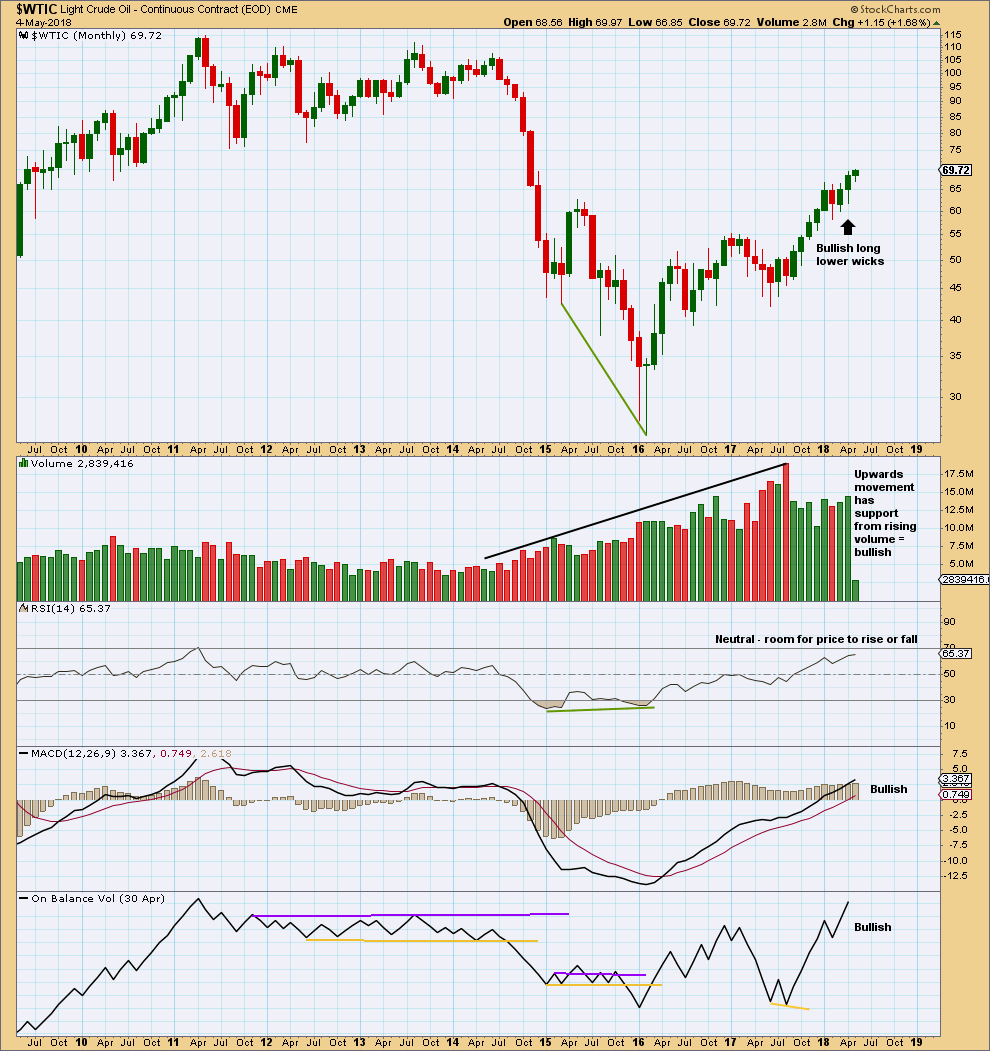
Click chart to enlarge. Chart courtesy of StockCharts.com.
For the last four months all now complete, the volume profile is bullish. There are now three completed monthly candlesticks with long lower wicks.
This chart is overwhelmingly bullish. It supports the main Elliott wave count.
Strong volume for the month of June 2017 may have been a selling climax. This is typical behaviour of commodities.
The strongest recent volume is a downwards month for August 2017. This is the only bearish indication on this chart.
DAILY CHART
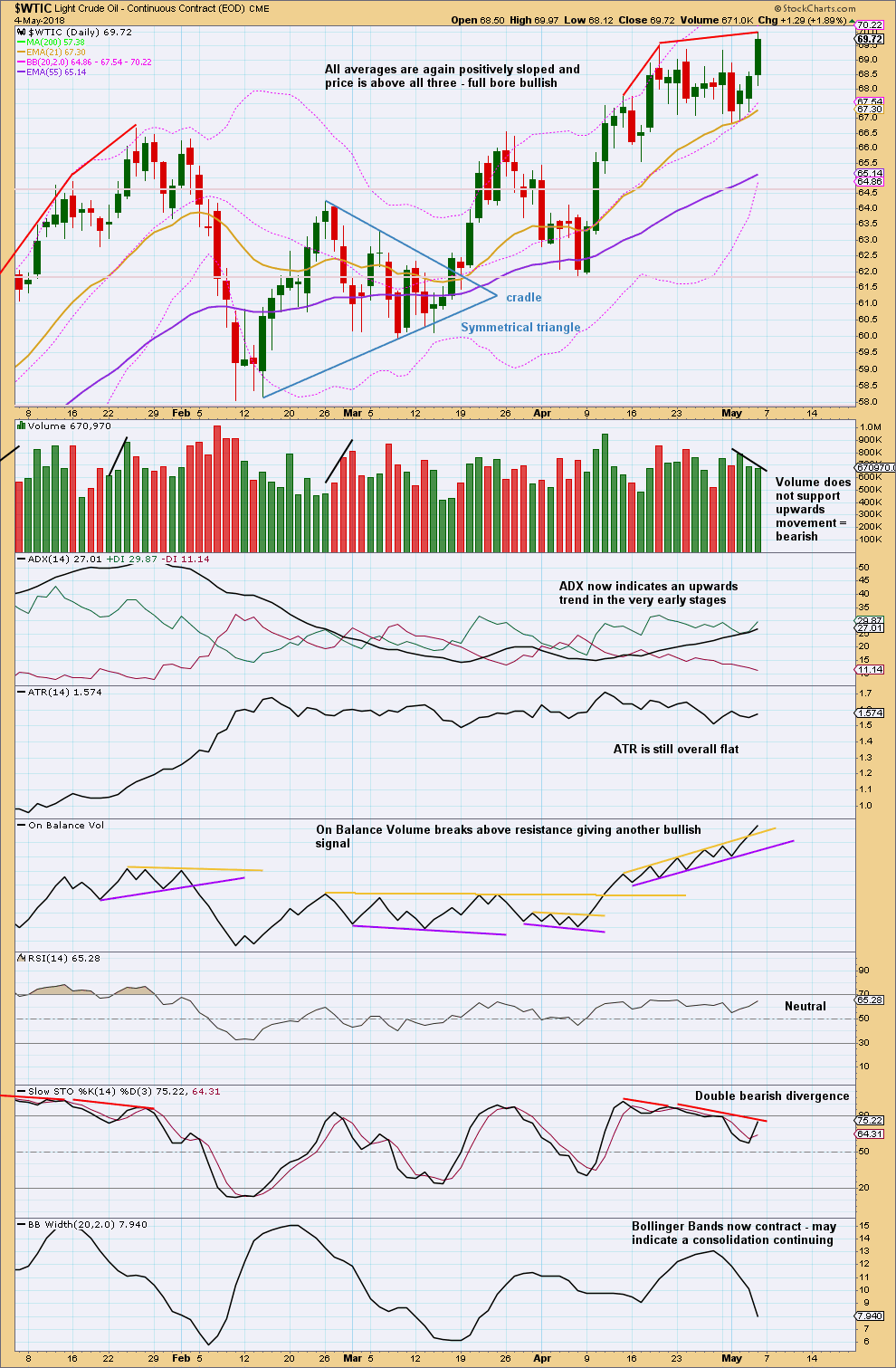
Click chart to enlarge. Chart courtesy of StockCharts.com.
It looks like a pullback may now occur for the very short term. Declining volume for the last two sessions and strong double bearish divergence between price and Stochastics support this view.
It looks like Oil is in a new upwards trend for the mid to long term. ADX and very bullish On Balance Volume support this view.

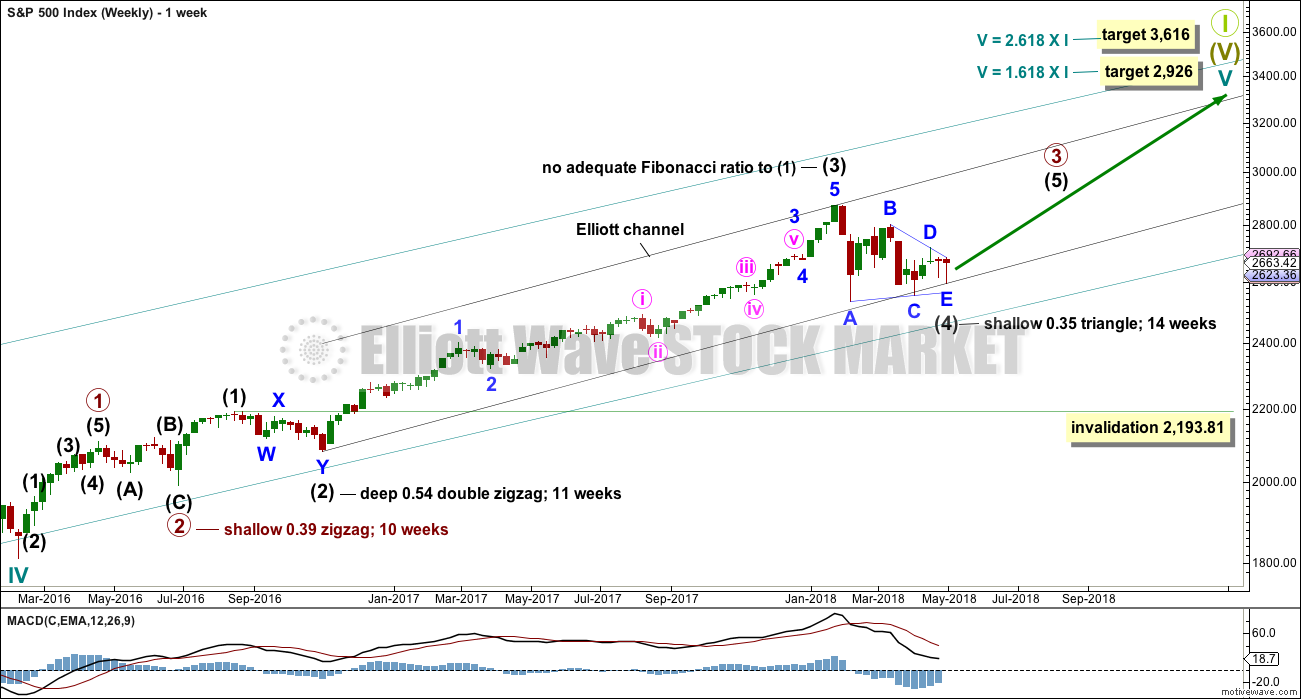
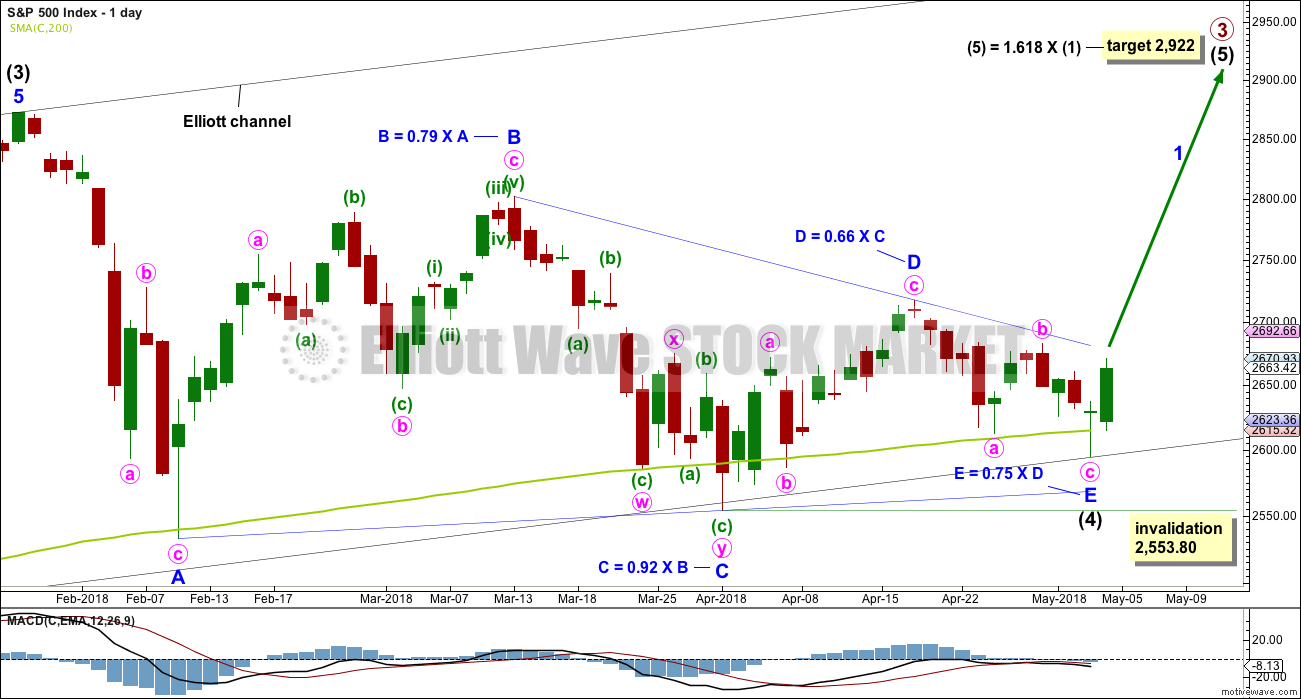
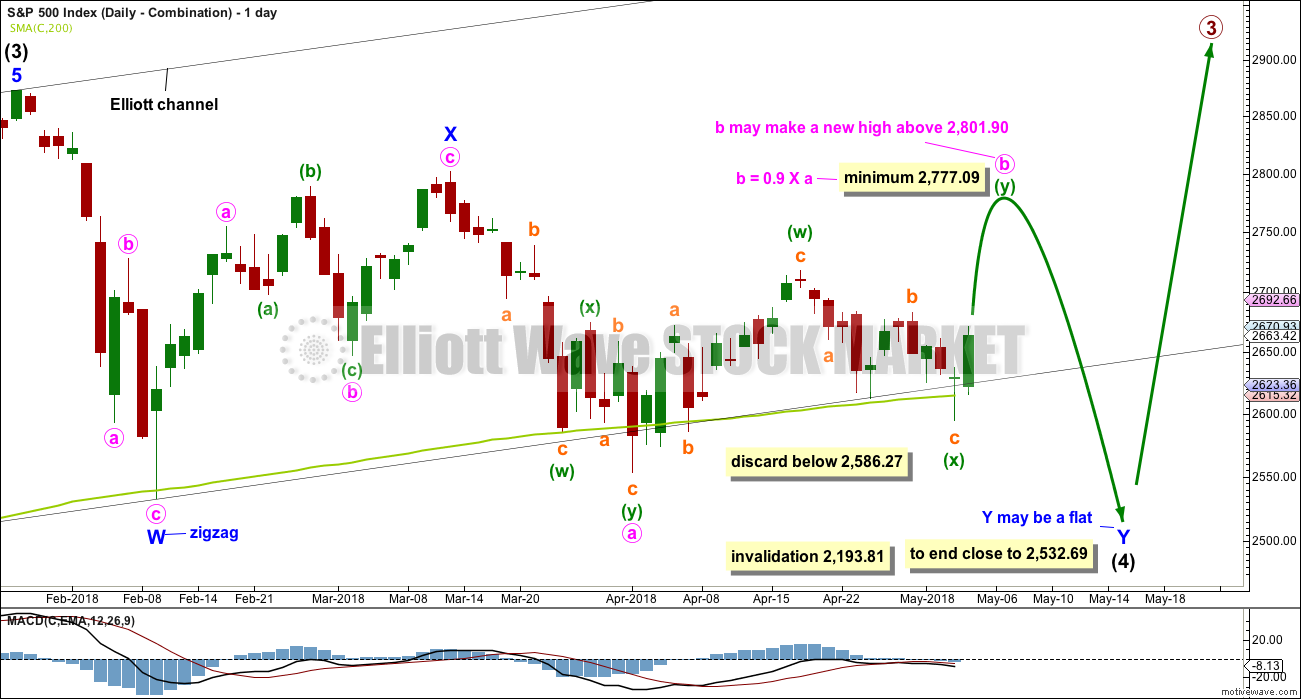

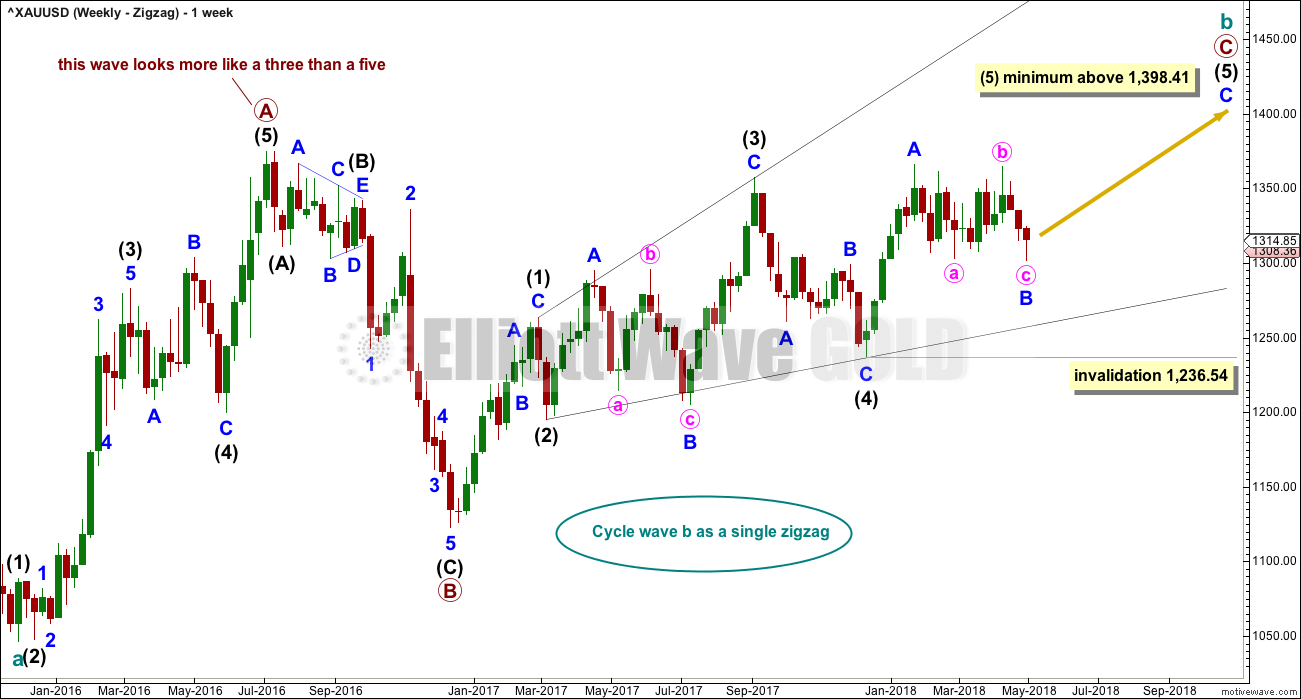
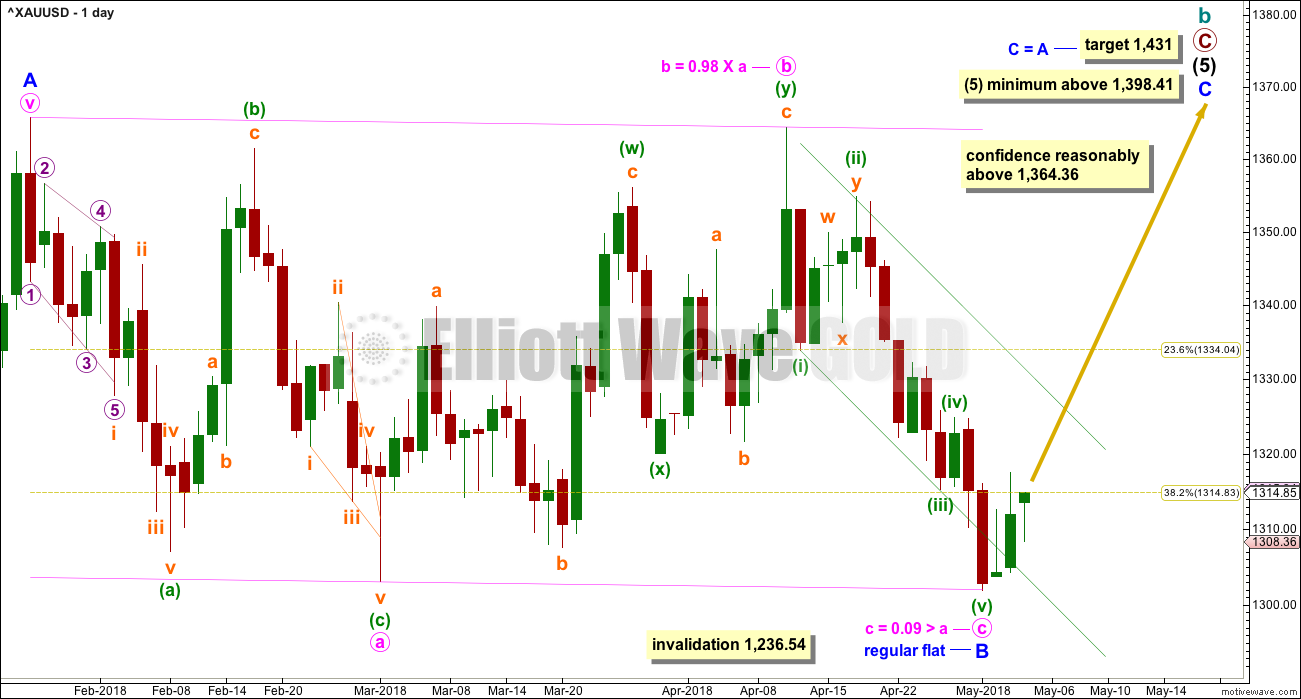
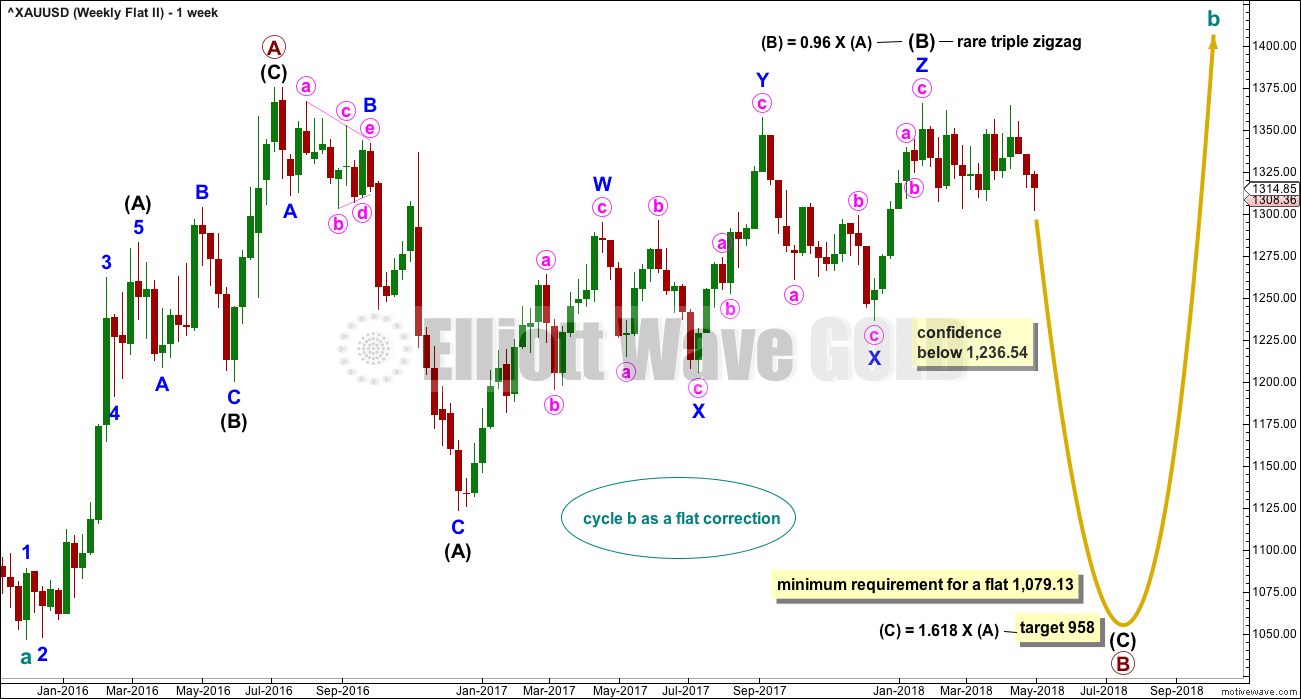
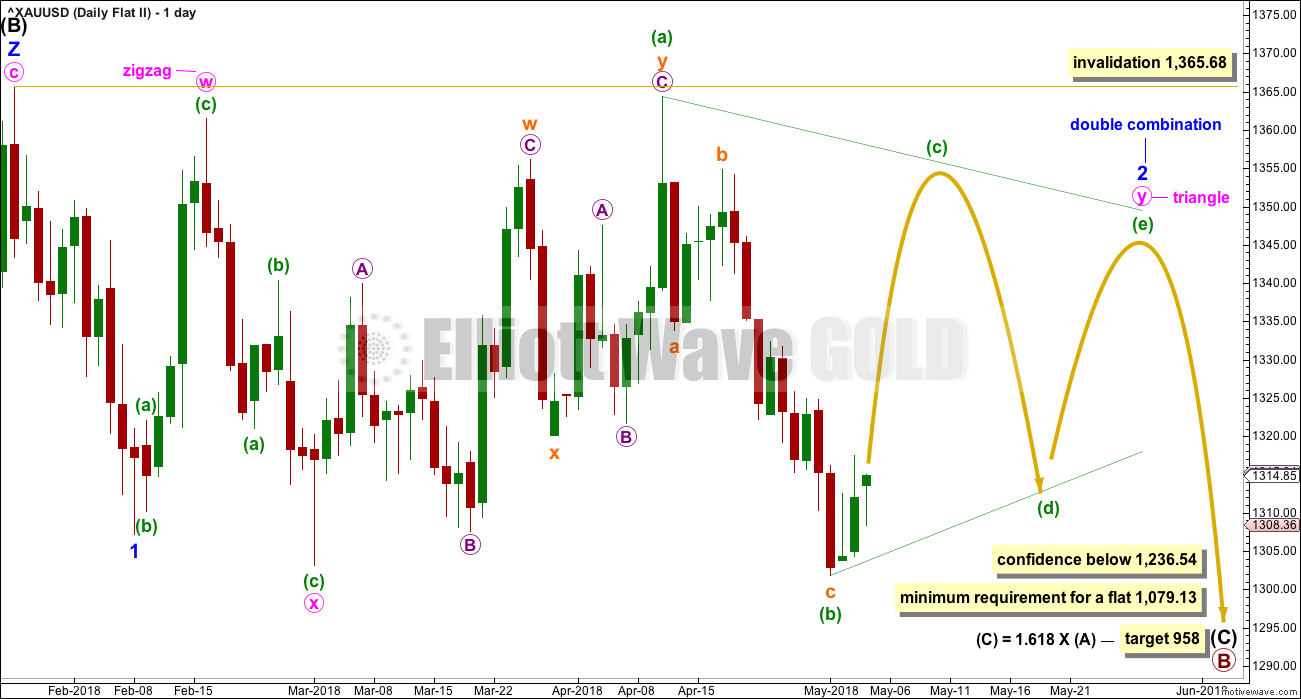
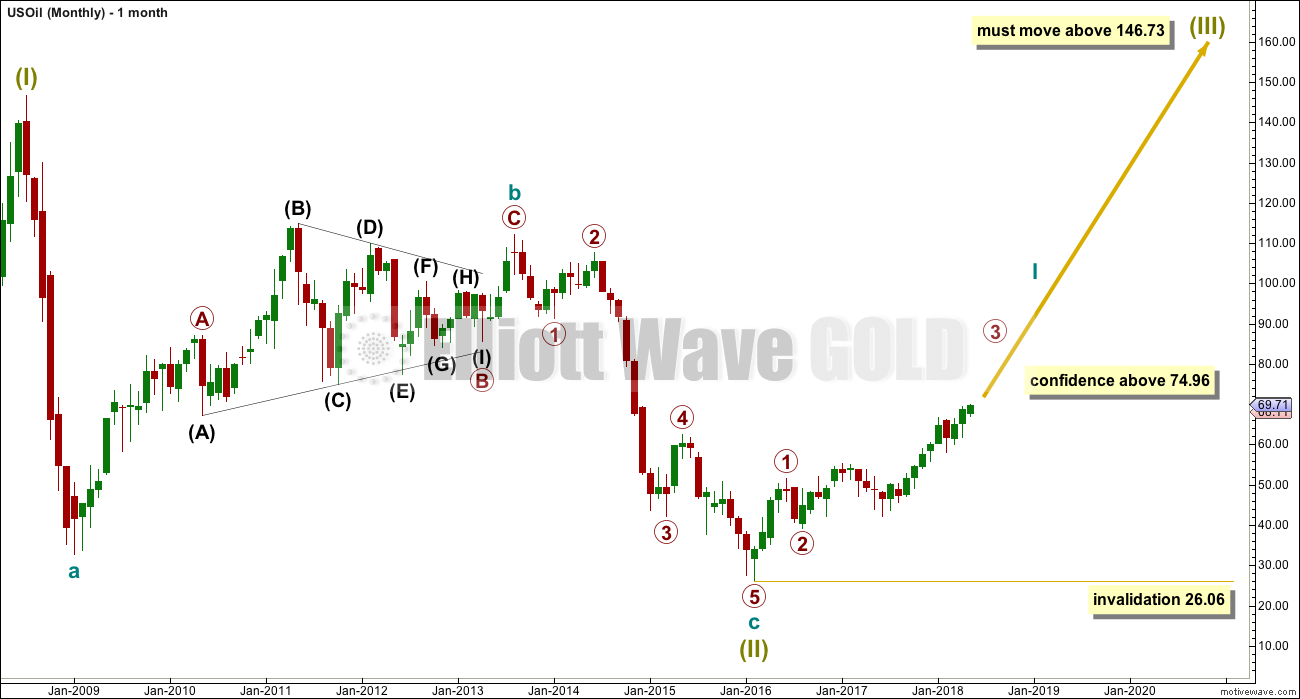
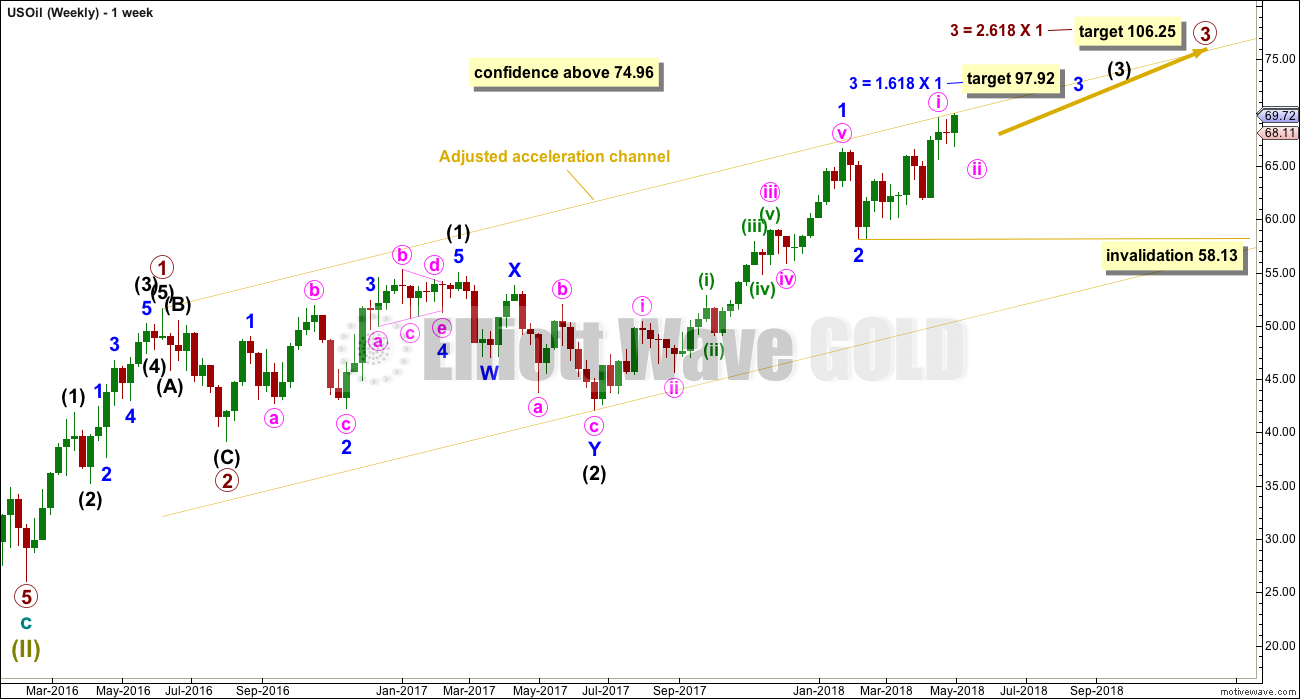
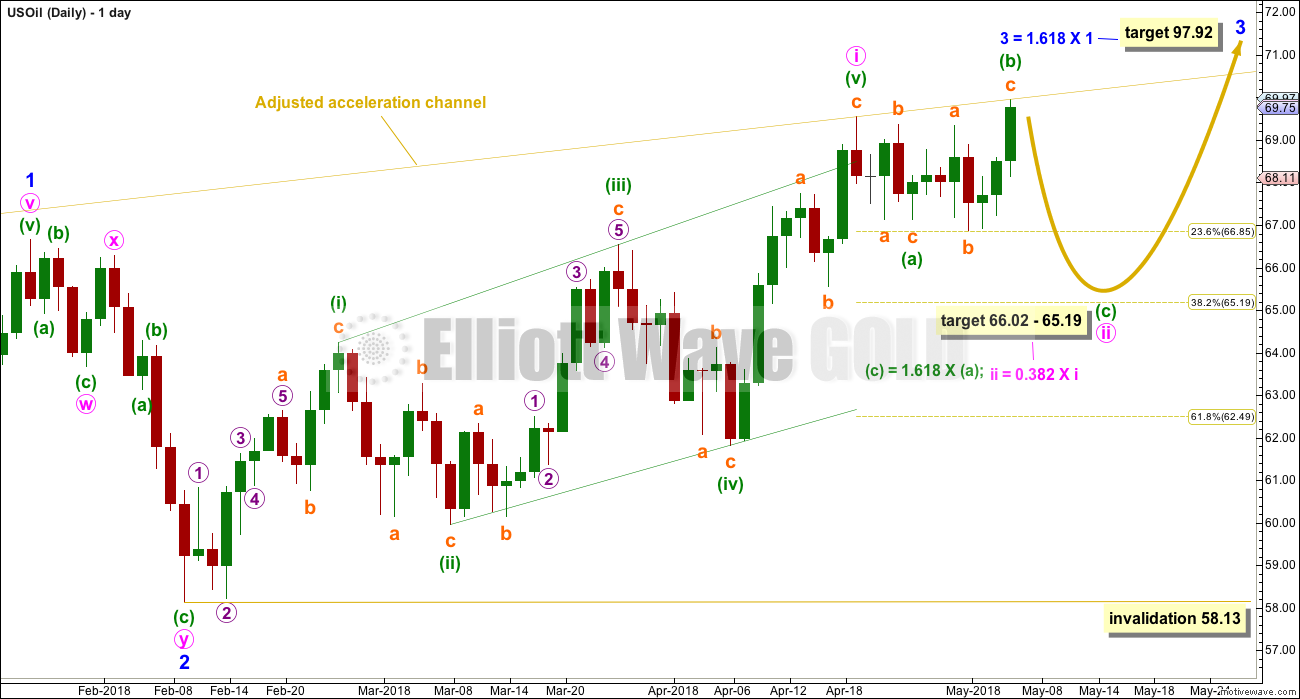

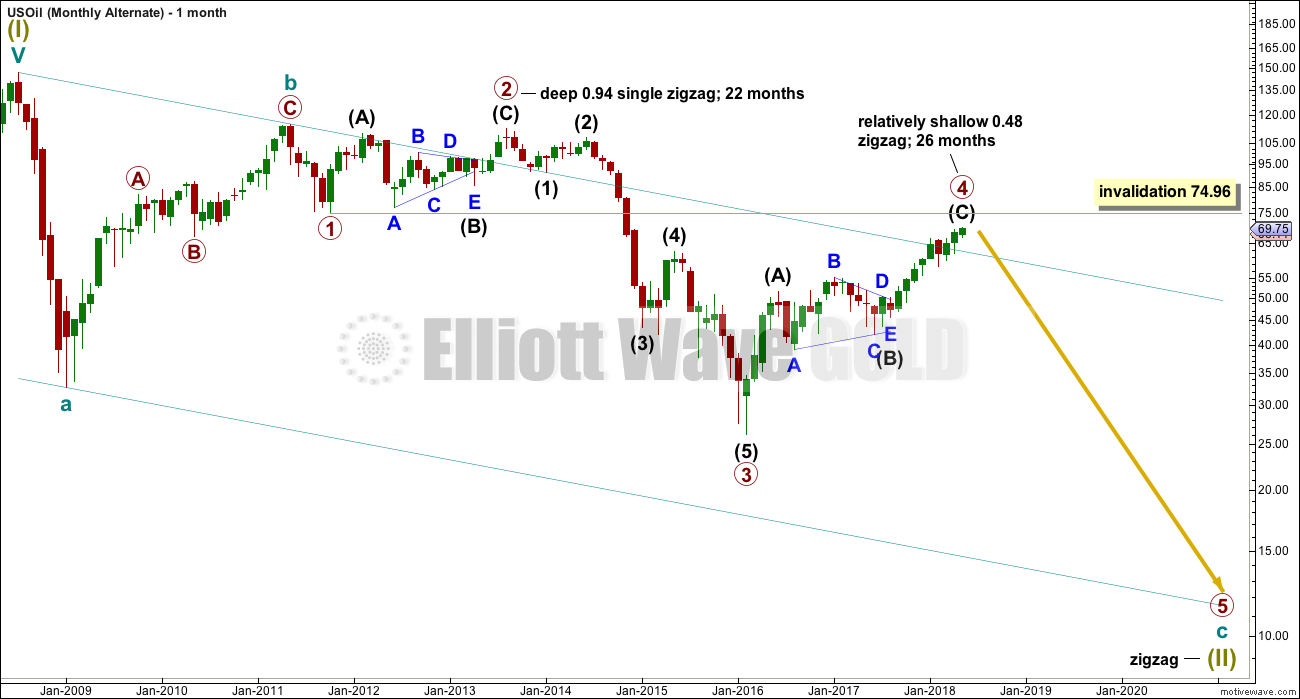
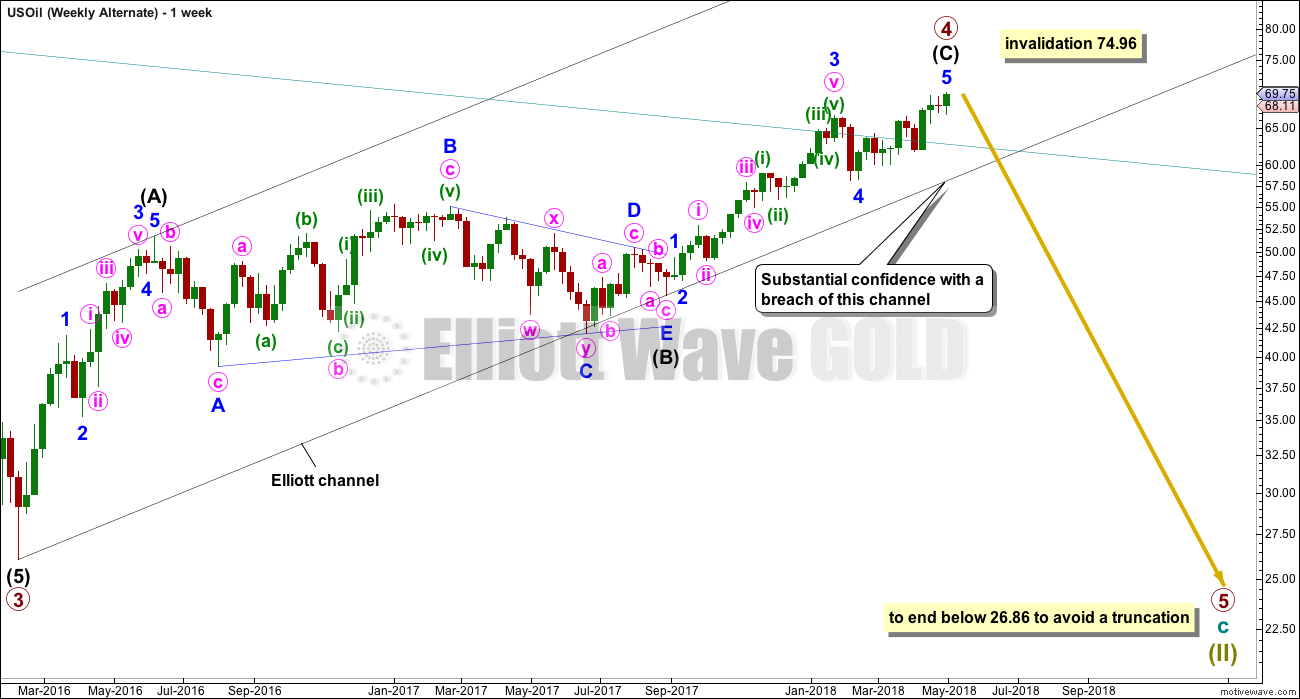
Hi Lara,
With the USOIL move upward, I have tried to find other possible wave counts consistent with the observed divergences which suggest a coming pullback. I may have found one. Does this one seem like a viable possibility?
Oh yeah, it actually looks pretty good. I’d see your minute iv over at the next swing low though as a triangle.
Hi Lara, I would like to know if you the second Elliott Wave
daily chart is more accurate for oil now . Thank you.
No, I still don’t think so despite a new high two days ago.
For the first preferred wave count for Oil, minuette (b) may be labelled as possibly over at the new high and would be 1.52 X the length of minuette (a).
B waves within flats may make new price extremes beyond the start of the A wave. Expanded flats do this, and they’re very common structures. A common length for B waves within flats is from 1 – 1.38 X the length of the A wave, and a convention within EW states that when the B wave reaches 2 X the length of the A wave the idea of a flat should be discarded due to a very low probability.
It’s not that long yet.
Now it’s looking more and more likely.
Updated daily chart for Gold:
Elliott wave count:
While the first daily chart published in the analysis above remains valid and remains the preferred wave count with a higher probability, today this alternate idea must be considered.
It is possible that lows may be tested one final time before an upwards move begins with strength.
If lows are tested again I would expect strong support about 1,300. A small overshoot of the lower pink trend line. And then a strong bounce upwards about there.
Use the channel on this chart. If upwards movement breaches it (at the hourly chart level) then have confidence a low is in place. At this time a new high above 1,318.53 (today’s high) would also provide confidence that a low is in place.
Notice that short term volume profile has changed retrospectively. This is because technical analysis with StockCharts data was done early for end of week analysis, StockCharts don’t always finalise their data until after 6:30pm EST.
Friday’s volume supported upwards movement. Now Monday has a balance of volume down and volume does not support this fall in price.
The short term volume profile is bullish supporting the idea a low may be in place. This view still has support from bullish divergence between price and On Balance Volume and price and Stochastics while oversold.
Much appriciated, Lara.
Since 1300 has long been regarded as a possible support, Mr.Market might take the price just a little below that, one last shake off and then proceed on upwards to your target.
Thank you kindly.
You’re welcome. Yes, that is of course entirely possible. A breach of 1,300 may be seen by many to be very bearish, only for price to turn and move higher.
That’s one of the problems with resistance and support zones. They can sometimes be overshot, only for price to return back above or below them.
Hi Lara,
Doesn’t it seem like the low in gold is not get in, that is the B wave is not over, but rather, we are in a wave 4 on the daily? It seems to me likely that gold can go lower into the 1280s, if not lower, before it rallies in a C wave.
Yes, I agree. This upwards movement of the last four days looks weak. As it remains within the channel it could be a fourth wave correction. I’ll be publishing an alternate daily chart in comments here later today after I’ve completed the Gold analysis.